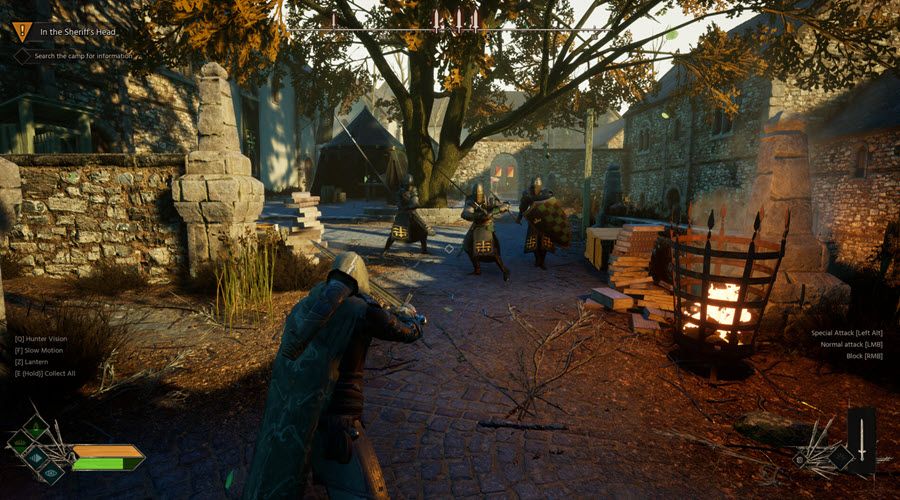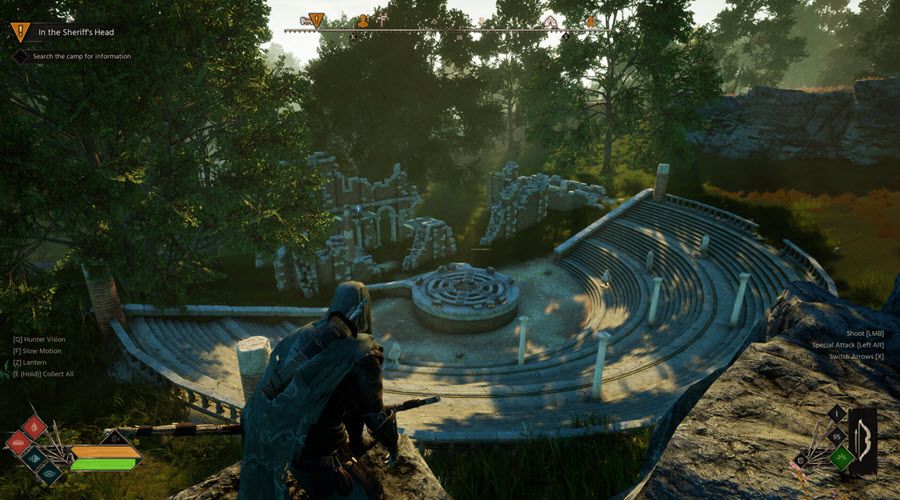Robin Hood - Sherwood Builders

Review
Robin Hood – Sherwood Builders is an open world action RPG with base-building elements in which you play as the legendary hero who steals from the rich and gives to the poor. While I’m not much a fan of construction games, I must say that the core idea of an open world game with this setting is awesome and I can’t believe nobody has tried to do this before. It is, of course, a very ambitious concept and the developers probably included more than they could handle, but the level of immersion is great, especially if you like the Middle Ages setting. The introduction is a bit awkward though. You begin the adventure in the middle of the forest and the main quest immediately starts, without any proper introduction other than a short animated video which quickly describes the events that brought you here. In short, after Prince John’s betrayal against his brother King Richard, you and your small band (Little John, Friar Tuck and Lady Marion) become outlaws and are forced to flee in the Sherwood Forest, while Prince John forces people to pledge their loyalty with the use of force, thanks to the help of the ruthless Sheriff of Nottingham. The plot is well-known if you have read the books or watched the movies and from what I have seen the developers haven’t made any drastic change to the main events. There isn’t much narrative (other than lore bites) while quest writing feels bland and generic, certainly not what you would expect from a modern open world action RPG.

The game’s objective is to free the four regions of the country after increasing your reputation in each area by defeating enemies and supporting the population. Once you have reached 40% of reputation in one region, you can complete the main quest and liberate the region. It’s a system that partially reminded me of Assassin’s Creed Odyssey and Valhalla, but on a smaller scale. It works, but the process of liberating each region soon becomes repetitive and boring due to the lack of variation between the type of activities, enemies and environments.
Speaking of combat, you can select the difficulty level between easy, normal or hard and I can say that normal offers a decent, not frustrating, challenge. Additionally, you can select between two combat modes: precise and dynamic. The first one is more realistic and allows positioning, proper enemy targeting and combo attacks. Dynamic instead offers a free posture that allows you to move around the enemy while fighting. Both these modes have their own pros and cons, but they are equally slow. You can try both to decide which one fits your playstyle better, and you can always change it through the game settings. Don’t expect a fully-fledged combat mode though. The movements feel incredibly janky, reminding me of old Gothic’s stiff combat. The low-quality of animations also doesn’t help to perceive weapons feedback and the game fails to deliver a satisfying combat experience. On the other hand, the game also features a simple but fun stealth system that ideally plays similarly to the latest Assassin’s Creed; for example, if the enemy has a lower level than yours, you can kill him silently.
At the beginning of the game, you are required to set up a small settlement which becomes your main headquarters and can be gradually expanded as you progress. Here you will receive your first training through a basic tutorial that covers almost every gameplay aspect. The game also includes basic survival elements such as Food and Water management, but finding supplies is very easy and makes the survival aspect meaningless. You can steal it from camps (with no repercussions, sadly) or buy it from traders. You can also cook food after you have built a kitchen in your camp. Expanding your settlement can be very important because it unlocks new weapons, skills and other useful items, but it’s not a requirement for enjoying the main quest. Buildings also need to be upgraded, and while there is some grind involved for retrieving the necessary resources, the construction itself is done by the settlers automatically.
Visually the game looks quite good, particularly the lighting, vegetation and some environments that are very detailed. Perhaps that’s why the exploration feels rewarding, despite the fact that the only way of moving in this world is by foot or through fast travel (you can’t ride horses). The enjoyment from exploration unfortunately wears out when you see that the world is more static than imagined. NPCs offer the same type of repetitive tasks (tracking, escorting or freeing someone) which increase your reputation in the region. Other events include the possibility of saving someone from public execution or hijacking a carriage transporting valuables. The performance on PC is decent, but there are still minor bugs (especially on the user interface) and gameplay elements that need more polishing.
Perhaps my expectations for an open world Robin Hood game were too high, but the developers tried to do many things without excelling in any aspect, unfortunately. If you are looking for a game more focused on exploration and base-building, Robin Hood – Sherwood Builders might offer some enjoyment, but those looking for well-written quests, engaging combat and true survival mechanics need to look somewhere else.
Review written by Sonic Punk for Zeepond.com
Robin Hood - Sherwood Builders Steam Store Page
Positives
+ Unique setting and fascinating open world+ Decent base-building mechanics
+ Good-looking visuals and environments
Negatives
- Quests are not interesting enough- Basic and meaningless survival elements
- Tons of repetitive activities
- Combat is too janky and inaccurate
- Still needs more polishing
Review Summary
A game perhaps too ambitious for what it promises, Robin Hood – Sherlock Builders ends up sacrificing combat and story in favor of base-building and exploration.
Share this review!
Zeepond Rating: 6/10










Video
Game Categories
All Game Reviews (1352)Hardware Reviews (0)
Action (341)
Adventure (151)
Alpha Games (2)
Anime (5)
Board Games (3)
Casual (135)
First Person (19)
First Person Shooter (30)
Hardware (0)
Horror (38)
Massive Multiplayer Online (4)
Pixel Graphics (22)
Platformer (94)
Puzzles (64)
Racing (26)
Role Playing Game (61)
Simulation (53)
Sports (20)
Strategy (246)
Third Person (11)
Utility software (1)
Virtual Reality (22)

